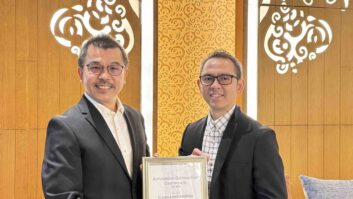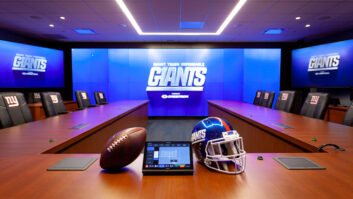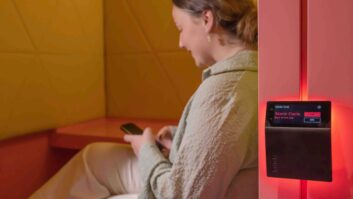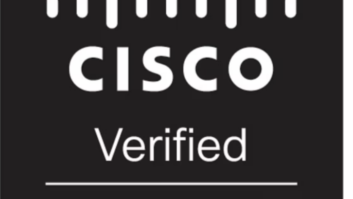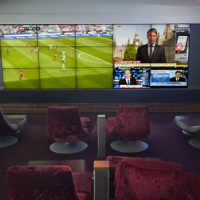
After undergoing rapid technological development in recent years, the scaling and switching industry shows no signs of slowing, with unified audiovisual and data network systems continuing to work as integral parts to many AV environments. Pictured is the Virgin Airlines’ latest upper class lounge at Heathrow Airport.
It has long been the goal of system integrators to specify and install unified audiovisual and data network systems into their clients’ sites, while minimising cabling and maximising reliability and functionality. Equipment manufacturers have responded with products that further this goal to the extent that it is now possible to install single systems that accommodate the majority of user requirements and utilise the most appropriate local transmission infrastructure.
The world has come a long way since VGA was the sole connection for computers and component for TVs. It is now common for a combined system to deliver multiple forms of analogue and digital video to different displays while at the same time offering internet access and data transmission over a single CatX or fibre cable over enormous distances to many concurrent users.
One of the major advances has been the multi-format switcher, a device capable of receiving a number of simultaneous signals of different formats and routing them to dedicated displays. “As long as manufacturers fail to agree on one standard, it is perhaps utopian to think that we can do without these multi-format switches,” explains Frank Facon, worldwide communications and marketing director at Analog Way. “System integrators need to look at solutions linking the past with the future to enable legacy analogue formats to be handled at the same time as the latest digital format.”
In practice multi-format switches usually consist of signal translation units around a large crosspoint router, all from the same manufacturer and packaged as discrete devices or within a modular, integrated system. This approach achieves the flexibility demanded of the system and does, to some extent, provide future proofing by allowing new formats to be accommodated on new plug-in cards or boxes.
Facon adds: “The solution today is to use a ‘versatile’ matrix that converts input signals to match them to the outputs. At first this approach may appear costly compared with a solution where each input signal is standardised prior to input to the matrix switcher, but the need for ‘handshaking’ and other communications between devices make the ‘versatile’ matrix a truly flexible and cost-effective answer.”
Complex setup
A major complication within digital AV transmission is the overhead and complexity of signalling and copyright protection. Digital handshaking by means of bidirectional signals transmitted between individual source and display devices is achieved automatically and transparently in a small point-to-point setup, but in a more complex installation, these become more complicated and failure to handle them correctly can be costly.
“EDID issues can crop up when you are matrix switching or doing any type of switching because the display doesn’t always retain the standard resolution and timing information that ensures a consistent picture. Sometimes you can lose data or even have a complete loss of video,” says Hagai Gefen, CEO of Gefen.
“With HDCP, one of the biggest challenges used to be the delay while a handshaking process took place, which could be frustrating to the integrator and users. We have implemented procedures to manage these situations. EDID information is detected at source and constantly transmitted to the connected display even when it is switched to another computer, and Fast Switching Technology (FST) reduces the 10-second delay caused by HDCP handshaking when switching sources to zero.”
The drive to provide unified systems and the ever-increasing scope of digital signal standards has led to new options for integrators. Of particular relevance to the new regime are HDMI 1.4 and Displayport. HDMI 1.4 adds a data channel to the HDMI connection, enabling high-speed, bidirectional communication.
Connected devices that include this feature can send and receive data via 100Mbps Ethernet, making them instantly ready for any IP-based application. It also adds an audio return channel (ARC) that will reduce the number of cables required to deliver audio ‘upstream’ from a display back to the router or source device for processing and distribution. It is applicable when the end display device has some sort of receiver such as a set-top box or equivalent and is useful for audio streams from microphones on cameras or headsets.
HDMI 1.4 supports 3D and 4K resolution video, as does Displayport 1.2. Both, however, come with the price of requiring even more bandwidth. According to David Jones at Lightware: “HDMI 1.4, a current standard, requires 10.2Gbps. The upcoming future standards such as Displayport 1.2 (21.6Gbps) and any new version of HDMI are likely to require anywhere between 20 and 23Gbps. This is why we introduced our 25G system. It’s capable of operation at 25Gbps per video channel and handles eight separate ‘media layers’ in a multilayer switching mechanism capable of connecting audio, video, Ethernet, RS232 and multiple other control formats concurrently.”
The right signal
This ability to handle control signals through the switch is becoming far more common as more peripheral devices include the ability for remote control by Ethernet, IR, HDMI-CMC signalling, RS232 or other means, each requiring dedicated data channels and most needing bidirectional signalling capability.
“As a practical solution, being able to send control signals over the same single cable as the content makes immense sense and is an important feature of today’s installations,” explains Ezra Ozer, VP marketing at Kramer Electronics. “Many installations using pre-existing cable infrastructure cannot add additional cables for control systems and in those cases a combined solution is crucial.”
These types of systems can be integrated into a building management system, as Matthew Buck, commercial account manager at Crestron UK, explains: “From a centrally managed programme we are now able to bring the AV and IT systems on to the same standard for the monitoring and management of environmental systems such as heating, AC, lighting, security and room scheduling. Having this level of control allows you to schedule downtimes and automatic shutdowns, manage energy consumption, perform remote diagnostics and troubleshooting, and allocate room and asset bookings.
“With a system such as Crestron’s Fusion, installers can put all these elements on to one operating system, which is incorporated into an organisation’s existing systems. This interoperability is a real benefit in minimising the expense when upgrading to these systems and protects the company’s investment.”
The ability of many modern signal management systems to handle high-definition signals and beyond is allowing them to be used in applications that were previously the domain of dedicated broadcast equipment. Bjørn Lunde Kristensen, general manager and CTO at TV Vest, has made the transition in a recent installation at Norwegian football team Viking FK. “What is striking about the latest generation of products is that we are no longer restricted to the general broadcast signal standards and high-cost equipment such as HD-SDI transmission and broadcast routers,” he says. “Instead we use fibre or CatX cables and Blackmagic Design production switchers based on HDMI, DVI and DisplayPort topology. This increases flexibility and lowers cost, making it more economic to build broadcast-quality systems in lower-value installations.”
Cable choice
Flexibility in choice of cables is a major criterion across switching systems at all levels of application. Hagai Gefen notes the variation: “Common methods of wiring a stadium and a conference room can be vastly different as integrators seek the most economical and stable method of distribution. Sending high-definition video over distances less than 100m can be achieved using standard Cat5 cable. A conference room would be more apt to use Cat5 cabling although wireless technologies are a viable solution for in-room AV distribution.”
Most single-cable transmission systems include the capability to mix-and-match copper and fibre cables to provide the greatest choice to installers, allowing copper to be used over short runs and fibre for more distant extremes.
Manufacturers are faced with responding to customer demand while simultaneously developing products that are economic for specific markets in an ever-complex environment. Modular design is one approach that is taken by many, allowing system integrators to build transmission architectures around dedicated requirements and allow for future growth. In other situations this is not viable, and dedicated products are designed and supplied for specific purposes. Typically devices such as videowall controllers, multi-display processors and effects generators fall into this category.
The most appropriate partitioning of systems is a key element: if manufacturers do it incorrectly they face producing products that appeal to far too few customers. However the benefits are worth the investment, resulting in products that combine functions. TVOne, for example, has combined video routing, switching and video up, down, cross-conversion and scaling into a platform using plug-in cards to accommodate up to 32 HDMI or DVI inputs and outputs with 3G HD-SDI options. Aimed at general applications, additional features can be incorporated as required to manage edge blending of multiple projector systems and videowall control.
The distribution of uncompressed signals takes considerable transmission bandwidth; a viable alternative is to compress video to some extent to reduce this bandwidth. HDBaseT is beginning to establish a foothold in the market, with some major manufacturers already well along the path of adoption in some of their products.
“By all accounts the HDBaseT protocol should be better known, it is a major step forward for those that wish to send digital signals over a distance,” suggests Facon. “HDBaseT is a good alternative solution for connecting devices with DVI-D, HDMI or DisplayPort, capable of fully supporting a signal over a distance of up to 328ft. Moreover, it is a much more cost-effective method of sending that signal, which can cost up to 10 times as much using more conventional methods. It has sufficient bandwidth to fully support Full HD 1080p video, 3D, or 4K format, multi-channel audio, 100 BaseT Ethernet, control flow and pass 100W of power.
“From a development point of view, HDBaseT allows the integrator to pass this signal all down a single cable. The change of HDBaseT status from utilisation primarily in the domestic sector, to becoming available for professional integration solutions should be the duty of all signal management manufacturers.”
While the technology has progressed radically over the past few years, it is inevitably set to progress even further as greater processing capability enables more functionality and the ability of equipment to handle new technologies. New connection methods are already emerging: Thunderbolt, developed by Intel and Apple, will also likely emerge as a future connection technology with the capability of transmitting two channels of 10Gbps video and/or PCI data and 10W of power over copper cables, and the ability to daisy-chain sources onto a single display. It is highly likely that wireless transmission will become more significant as it becomes more robust.
“Distribution of audio and video is currently based on local storage and transmission using wired networks but, looking ahead five years or so, the future of connectivity will be radically different,” predicts Chris Bundy, director of marketing for Atlona. “I expect that it will be mainly Cloud-based, with wireless distribution giving a more decentralised architecture.”
www.analogway.com
www.atlona.com
www.blackmagic-design.com
www.crestron.eu
www.cslintegration.com
www.gefen.com
www.kramerelectronics.com
www.lightware.eu
www.tvone.co.uk
www.tvvest.no
